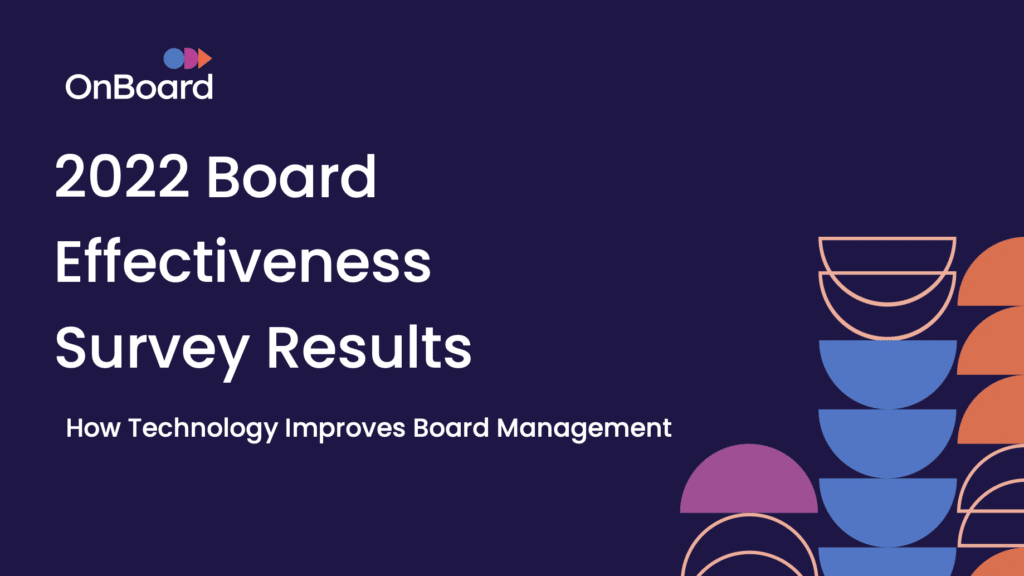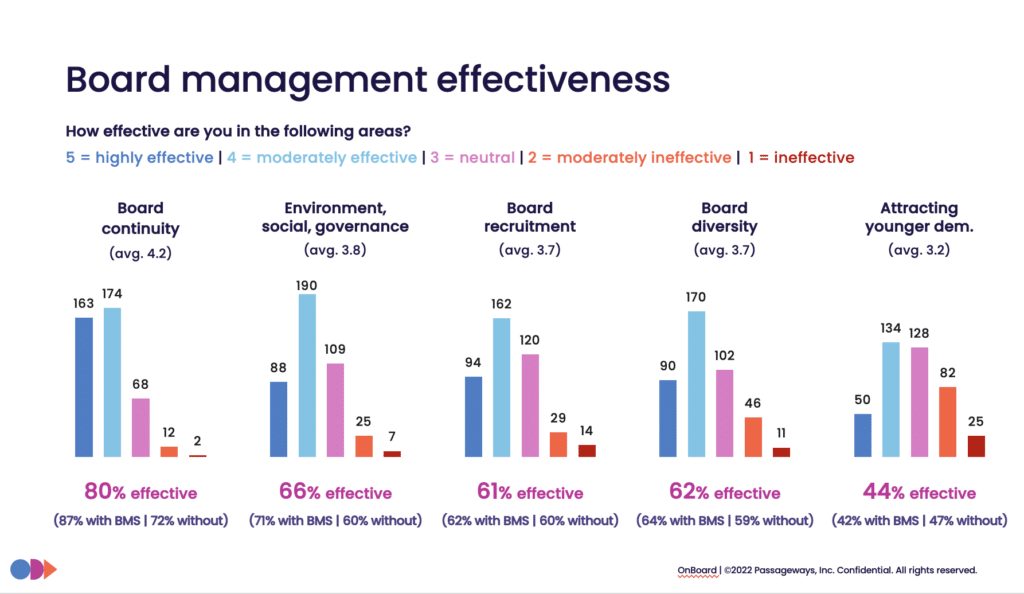
Webinar Recap: OnBoard surveyed more than 400 board leaders worldwide as part of their 2022 Board Effectiveness Survey. Here’s Part 2 of what they shared.
The COVID-19 pandemic has had a lasting effect on just about every facet of business – including the way boards of directors collaborate and get work done.
When the pandemic first hit, many businesses made the switch to remote work in an effort to keep employees safe and healthy. Boards of directors followed suit by shifting to remote board meetings. They also accelerated their adoption of technology to ensure they had the tools needed to remain collaborative and productive when in-person gatherings weren’t an option.
Today, most boards have settled into their “new normal” of remote meetings and increased use of technology. But does that mean the challenges of the early pandemic days have disappeared? Not exactly.
Key Takeaways from the 2022 Board Effectiveness Survey
Recently, OnBoard surveyed more than 400 board leaders to shed light on the areas in which boards thrived in 2021, where they struggled, and where they plan to go in the coming years. We also sought to understand the role of technology in helping boards overcome their key challenges and increase effectiveness.
This research yielded three key takeaways. We covered the first two in our previous blog. In case you missed it, here’s a quick recap:
- Using board meeting software consistently makes participants more effective, more collaborative, and more confident in the security of board communications.
- Board member engagement is the primary driver of board effectiveness.
In this blog, we’ll zero in on the third and final key finding of this research.
Key Takeaway No. 3: There’s a Clear Appetite and Need to Use Technology to Improve Board Effectiveness, Including Challenges Around Innovation & the Need to Attract Diverse Directors
An effective board is one that’s able to accomplish more for the organization it serves. Our survey explored the areas where boards are particularly effective, where they’re falling short, and what role technology plays in improving effectiveness in the following areas.
Board Continuity
Change is inevitable. Board directors join and exit the board on a regular basis, and business priorities are always shifting. Boards must ensure continuity – in spite of this constant change.
It’s clear continuity is a key focus, as 80% of boards feel this is an area in which they are effective. However, there’s a notable difference in effectiveness between those who use board management software and those who don’t. While 87% of boards using board management software feel they are effective in board continuity, 72% of those without board management software feel this way.

Environmental, Social, and Governance (ESG)
In the past few years, headlines have been filled with reports of environmental disasters, racial injustice, and alleged abuses by leaders. As such, there’s been increased pressure on boards to be proactive on environmental, social, and governance (ESG) issues.
However, our survey found that 66% of boards feel this is an area in which they’re effective. Those with board management software are significantly more likely to be effective in this area (71%) than those without (60%).
Board recruitment
Having the right blend of skills and background is key to the effectiveness of any board. Boards must identify where gaps exist, and recruitment efforts must focus on filling those gaps.
But for many boards, recruiting continues to be a challenge. Today, just 61% of boards indicate they’re effective at recruitment. This number is slightly higher – 62% – for boards that use board management software.
While recruiting for the right skills is important, it’s becoming increasingly vital to also recruit board members with diverse backgrounds. As Peter C. Browning (Founder and Managing Director of Peter Browning Partners, LLC and author of The Director’s Manual: A Framework for Board Governance) put it in a recent OnBoard webinar, focusing on diversity, equity, and inclusion (DEI) in the boardroom is “not optional. Rather, it must be a top priority.
Yet, 62% of boards feel they are effective with board diversity, leaving plenty of room for improvement. This percentage is two points higher – 64% – among boards with board management software.
Of course, there are many aspects of improving board diversity. For starters, boards must aim to recruit more women – as well as more people of color.
Boards must also aim for greater diversity in terms of age. However, this is a key challenge of many boards. A mere 44% of boards feel they are effective in attracting a younger demographic.
Take Action to Improve Board Effectiveness
While many boards are excelling at continuity, far fewer feel their ESG and recruitment and diversity efforts are hitting the mark. Here’s what boards can do to improve their effectiveness in the 5 key areas we’ve discussed, based on our survey findings.
Focus on diversity
As asset managers including BlackRock and Vanguard make their DEI stances clear, boards are under more pressure than ever to focus on diversity. This includes diversity in gender, race, geography, age, and experience – among others. It’s essential to identify gaps in your board and focus your recruitment efforts on filling them.
Embrace technology
Boards with board management software surpass those without in nearly all areas of board effectiveness. The right technology can streamline and simplify all aspects of board management, including communication, continuity planning, and recruitment.
Want to learn more about the top trends and drivers of increased board effectiveness in 2022? Check out the full survey.
Meet What's Next
About The Author

- Adam Wire
- Adam Wire is a Content Marketing Manager at OnBoard who joined the company in 2021. A Ball State University graduate, Adam worked in various content marketing roles at Angi, USA Football, and Adult & Child Health following a 12-year career in newspapers. His favorite part of the job is problem-solving and helping teammates achieve their goals. He lives in Indianapolis with his wife and two dogs. He’s an avid sports fan and foodie who also enjoys lawn and yard work and running.
Latest entries
 Board Management SoftwareApril 23, 2024How to Form a Crisis Response Team (Step-by-Step)
Board Management SoftwareApril 23, 2024How to Form a Crisis Response Team (Step-by-Step) Board Management SoftwareApril 12, 2024Board of Directors Compliance Training: 5 Best Programs
Board Management SoftwareApril 12, 2024Board of Directors Compliance Training: 5 Best Programs Board Management SoftwareApril 10, 20245 Best Compliance Training Programs
Board Management SoftwareApril 10, 20245 Best Compliance Training Programs Board Management SoftwareMarch 28, 20245 Advantages of an Initial Public Offering
Board Management SoftwareMarch 28, 20245 Advantages of an Initial Public Offering
